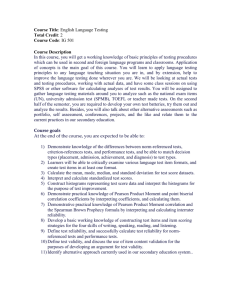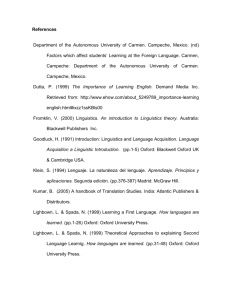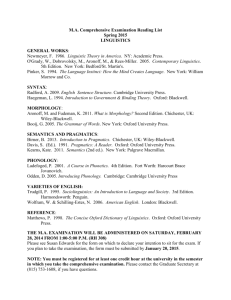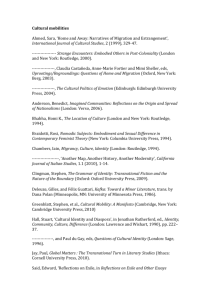Bibliography Vocabulary
advertisement
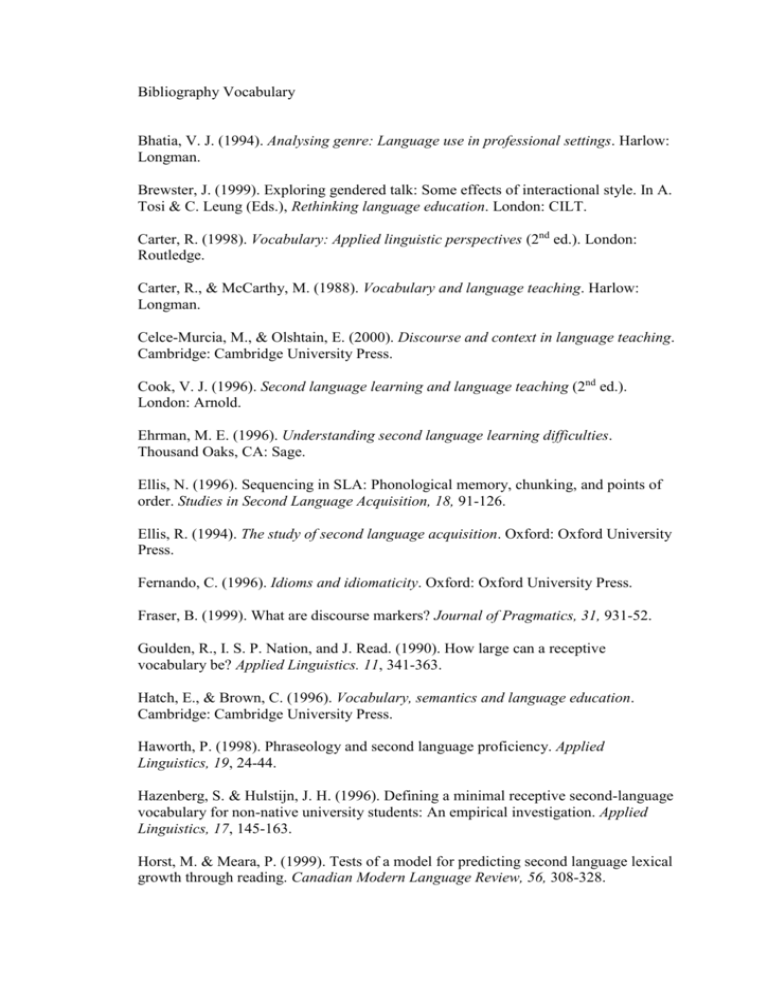
Bibliography Vocabulary Bhatia, V. J. (1994). Analysing genre: Language use in professional settings. Harlow: Longman. Brewster, J. (1999). Exploring gendered talk: Some effects of interactional style. In A. Tosi & C. Leung (Eds.), Rethinking language education. London: CILT. Carter, R. (1998). Vocabulary: Applied linguistic perspectives (2nd ed.). London: Routledge. Carter, R., & McCarthy, M. (1988). Vocabulary and language teaching. Harlow: Longman. Celce-Murcia, M., & Olshtain, E. (2000). Discourse and context in language teaching. Cambridge: Cambridge University Press. Cook, V. J. (1996). Second language learning and language teaching (2nd ed.). London: Arnold. Ehrman, M. E. (1996). Understanding second language learning difficulties. Thousand Oaks, CA: Sage. Ellis, N. (1996). Sequencing in SLA: Phonological memory, chunking, and points of order. Studies in Second Language Acquisition, 18, 91-126. Ellis, R. (1994). The study of second language acquisition. Oxford: Oxford University Press. Fernando, C. (1996). Idioms and idiomaticity. Oxford: Oxford University Press. Fraser, B. (1999). What are discourse markers? Journal of Pragmatics, 31, 931-52. Goulden, R., I. S. P. Nation, and J. Read. (1990). How large can a receptive vocabulary be? Applied Linguistics. 11, 341-363. Hatch, E., & Brown, C. (1996). Vocabulary, semantics and language education. Cambridge: Cambridge University Press. Haworth, P. (1998). Phraseology and second language proficiency. Applied Linguistics, 19, 24-44. Hazenberg, S. & Hulstijn, J. H. (1996). Defining a minimal receptive second-language vocabulary for non-native university students: An empirical investigation. Applied Linguistics, 17, 145-163. Horst, M. & Meara, P. (1999). Tests of a model for predicting second language lexical growth through reading. Canadian Modern Language Review, 56, 308-328. Huckin, T., & Coady, J. (1999). Incidental vocabulary acquisition in a second language: A Review. Studies in Second Language Acquisition, 21, 181-93. Levelt, W. J. M., Roelofs, A., & Meyer, A. S. (1999). A theory of lexical access in speech production. Behavioral and Brain Sciences, 22, 1-75. McCarthy, M. (1998). Spoken language and applied linguistics Cambridge: Cambridge University Press. McCarthy, M. J. & Carter, R. A. (1994). Language as discourse: Perspectives for language teaching. Harlow: Longman. Meara, P. & Buxton, B. (1987). An alternative to multiple choice vocabulary tests. Language Testing, 4, 142-151. Meara, P. & Fitzpatrick, T. (2000). Lex30: An improved method of assessing productive vocabulary in an L2. System, 28, 19-30. Mitchell, R., & Myles, F. (1998). Second language learning theories. London: Arnold. Moon, R. (1997). Vocabulary connections: multi-word items in English. In Schmitt, N. and McCarthy, M. (Eds.) Vocabulary: Description, Acquisition, and Pedagogy. Cambridge: Cambridge University Press. Moon, R. (1998). Fixed expressions and idioms in English. Oxford: Clarendon Press. Nation, I.S.P. (1990). Teaching and Learning Vocabulary. New York: Heinle and Heinle. Nation, P. (1995). The word on words: an interview with Paul Nation. Interviewed by Norbert Schmitt. The Language Teacher, 19, 5-8. Nation, Paul. and R. Waring. (1997). Vocabulary Size, Text Coverage and Word Lists. In Schmitt, N. and M. McCarthy (Eds.): Vocabulary: Description, Acquisition and Pedagogy (pp. 6-19). Cambridge: Cambridge University Press. Nattinger, J. & DeCarrico, J. (1992). Lexical phrases and language teaching. Oxford: Oxford University Press. Pawley, A. (1992). Formulaic speech. In W. Bright (Ed.), International encyclopedia of linguistics: Vol. 2 (pp. 22-25). New York: Oxford University Press. Pawley, A., & Syder, F. H. (1983). Two puzzles for linguistic theory: Nativelike selection and nativelike fluency. In J. C. Richards & R. W. Schmidt (Eds.), Language and communication (pp. 317-331). Harlow: Longman. Schmidt, R. (Ed.) (1995). Attention and awareness in foreign language learning. Honolulu, HI: University of Hawaii Press. Schmitt, N. (1998). Tracking the incremental acquisition of second language vocabulary: A longitudinal study. Language Learning, 48, 281-317. Schmitt, N. (1999). The relationship between TOEFL vocabulary items and meaning, association, collocation, and word class knowledge. Language Testing, 16, 189-216. Schmitt, N. (2000). Vocabulary in language teaching. Cambridge: Cambridge University Press. Schmitt, N., & McCarthy, M. (Eds.) (1997). Vocabulary: Description, acquisition and pedagogy. Cambridge: Cambridge University Press. Schmitt, N., Schmitt, D., & Clapham, C. (in press). Developing the Vocabulary Level Test. Language Testing. Schonell, F. J., Meddleton, I.G., and Shaw, B.A. (1956). A study of the oral vocabulary of adults. Brisbane: University of Queensland Press. Schumann, J. H. (1997) The neurobiology of affect in language. Oxford: Blackwell, Oxford. Skehan, P. (1998). A cognitive approach to language learning. Oxford: Oxford University Press. Weinert, R. (1995). The role of formulaic language in 2nd-language acquisition; A review. Applied Linguistics, 16, 180-205.

